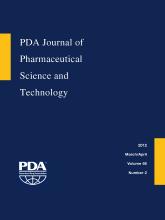Abstract
During the course of their manufacturing, storage, and administration, pharmaceutical drug products come in contact with materials, components, and systems. Such contact may result in an interaction between the drug product and these entities. One such interaction is the migration of substances from these entities and into the drug product, which is of concern due to the potential toxicity of the migrating substances. In order to properly assess the risk and manage the hazard posed by migratory substances, it is necessary to establish the identities of the migratory substances and the levels to which they will accumulate in the finished drug product, as these two pieces of information establish the hazard posed by an individual substance and the magnitude of the patient exposure (dose). The process by which migrating compounds are discovered and identified, and by which their accumulation levels in a finished drug product are established, is termed chemical assessment. Because the development of a finished drug product is a long and complicated process, chemical assessment is most typically not a single action but rather a series of actions that together establish a process of risk management. It is the purpose of this manuscript to establish a high-level strategy, illustrated in the chemical assessment triad, which can be applied to such a risk management process.
LAY ABSTRACT: During the course of their manufacturing, storage, and administration, pharmaceutical drug products come in contact with materials, components, and systems. Such contact may result in an interaction between the drug product and these entities. One such interaction is the migration of substances from these entities and into the drug product, which is of concern due to the potential toxicity of the migrating substances. It is the purpose of this manuscript to outline a high-level strategy, illustrated in the chemical assessment triad, to chemically establish the safety risk related to the migrating substances.
- © PDA, Inc. 2012
PDA members receive access to all articles published in the current year and previous volume year. Institutional subscribers received access to all content. Log in below to receive access to this article if you are either of these.
If you are neither or you are a PDA member trying to access an article outside of your membership license, then you must purchase access to this article (below). If you do not have a username or password for JPST, you will be required to create an account prior to purchasing.
Full issue PDFs are for PDA members only.
Note to pda.org users
The PDA and PDA bookstore websites (www.pda.org and www.pda.org/bookstore) are separate websites from the PDA JPST website. When you first join PDA, your initial UserID and Password are sent to HighWirePress to create your PDA JPST account. Subsequent UserrID and Password changes required at the PDA websites will not pass on to PDA JPST and vice versa. If you forget your PDA JPST UserID and/or Password, you can request help to retrieve UserID and reset Password below.






